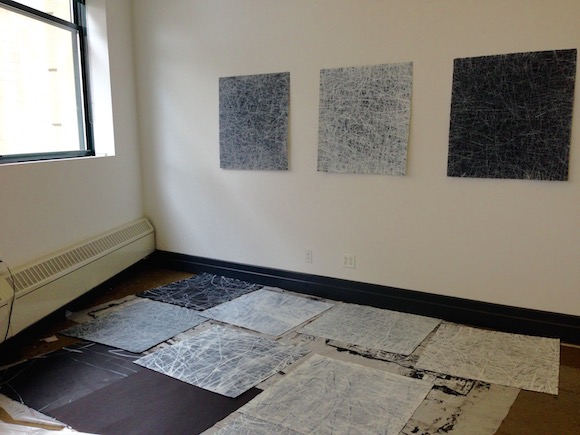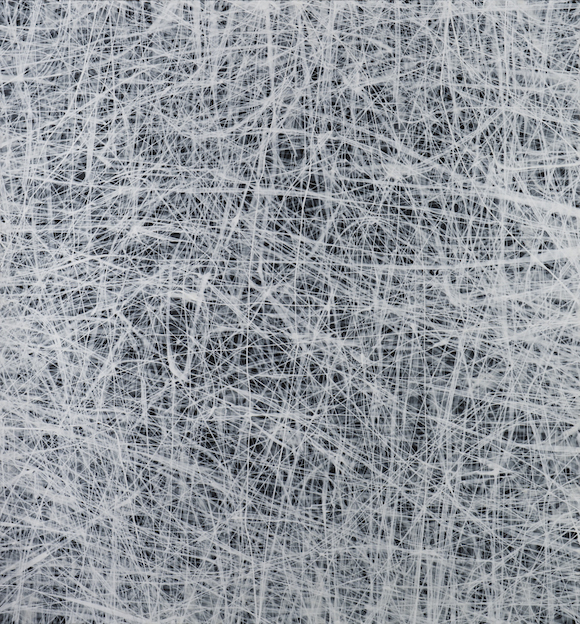
Erin Wiersma’s studio space at the Two Coats of Paint Residency, New York, 2015. Photograph: Jacquelyn Gleisner.
In June, I visited the studio of Erin Wiersma at the Two Coats of Paint Residency in the neighborhood of Downtown Brooklyn. Sharon Butler—artist, writer, and founder of the Two Coats of Paint blog—invited Wiersma, an artist from Kansas, to inaugurate the new residency program. The program encourages artists based outside the New York City area to use the space for studio visits with curators and critics. After a twenty-hour drive across the country, Wiersma arrived late on a Saturday night. When I entered the space on the following Thursday morning, drawings on heavyweight watercolor papers painted black, layered with lines of varying weights of white pigments, were scattered across the floor and pinned to the walls. Smaller works on paper with graphite were stacked on tables. Wiersma—an artist who self-identifies as drawing-based—told me, “Drawing is a way of being.”
For Wiersma, drawing is a process that emphasizes searching and understanding. Reflecting on her childhood, Wiersma explained that her understanding of the world has been affected by a difficulty with processing auditory information. Sounds can be immediately recognized and understood, but the meanings found by decoding language could be delayed or distorted. Words can become garbled in the extended period of time that is sometimes required to parse their meaning. Over time greater meaning can be and is found. Wiersma stated, “For me, more is communicated and revealed in the cadence and tempo of spoken words and bodily gestures.” [1] Words convey a message, yet for Wiersma the delivery of the message is of greater importance.
In the same way, the process and medium of drawing echo the meaning of Wiersma’s work. Wiersma draws because she favors the senses of immediacy and earnestness she discovers in the process. A direct relationship exists between the marks Wiersma makes on the paper and the movements of her body as she traces and retraces these gestures. Wiersma’s drawings—restricted in material to graphite or black and white pigments on paper, using values but never other colors—record a direct desire to comprehend her interactions with other people and her perception of the world.

Erin Wiersma. Selection from the Examen series, 2015; dispersed pigment on paper; 31 x 33 inches. Courtesy of the artist. © Erin Wiersma.
For example, Limestone is a series of graphite works on twelve-inch-square pieces of white paper that began with frottage. Wiersma rubbed the surfaces of limestone slabs that lined a pathway leading to her house in Manhattan, Kansas. The highest peaks of the stone slabs became marks on the paper. The results of this process were like topographical maps of surfaces the artist encounters daily. Wiersma repeatedly traced and connected these beginning points, which are obscured by the repetition. “I aggressively push the netting of lines to a state where the original points cannot be retained or remembered,” she said. Slowly Wiersma constructs dense networks between these dissolving points, forming meditations on the negative space, a parallel to the time between words in verbal communication.
Wiersma believes that drawing is a nonlinear mode of expression. Drawing mimics the structure of spoken language, using points and lines to represent words and the spaces between them. Inside Wiersma’s studio, I wanted to look past the marks and into the negative space, the depth of which has the sublime sensation of a limitless void. Decoding or deciphering words, as they are spoken can at times present a challenge for Wiersma, but in her drawings, the negative space offers a static sense of time. Like a poem that is memorized and recited, a drawing by Wiersma is intended to be viewed with patience.
In fact, Wiersma noted that one poem in particular captures the idea of the atemporal that she strives to uncover in the drawing process. In “Burnt Norton” (1935), the first poem in the Four Quartets, T.S. Eliot wrote: “Time past and time future / What might have been and what has been / Point to one end, which is always present. /… / At the still point of the turning world. Neither flesh nor fleshless; / Neither from nor towards; at the still point, there the dance is, /… / At the still point of the turning world.”[2]
Wiersma explained to me, “Through my drawings, I begin to witness the still point, an eternal sense of time, and know the otherness.” The meditative process allows Wiersma to enter this realm, and the drawings also evoke this other world, where still points embody the movements of the artist’s language.
—————-
Erin Wiersma was born in Somerville, NJ, and received a BA at Messiah College in Grantham, PA, and an MFA from the University of Connecticut, in Storrs, CT. She currently resides in Manhattan, Kansas, where she is an assistant professor of art at Kansas State University.
—————-
[1] All of Wiersma’s quotes are from a conversation with the author, June 18, 2015.
[2] “Burnt Norton,” T.S. Eliot Poems: The Four Quartets.



